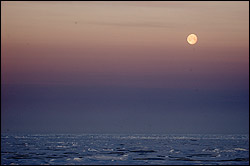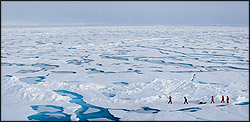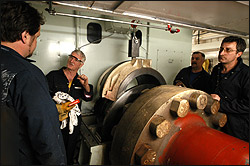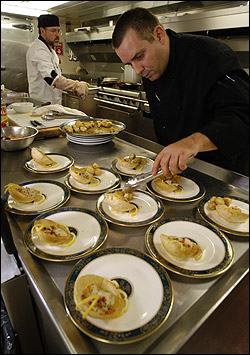Please note: You are viewing
the unstyled version of this website. Either your browser does not support CSS
(cascading style sheets) or it has been disabled. Skip
navigation.
Chris LinderAugust 21, 2005As a photographer I love watching light. Even though the ice fields around us haven't changed since we suffered our engine failure three days ago, the light is constantly changing. My favorite time for light watching is around 3AM, when the sun casts a soft warm glow on the ice. Last night a special surprise greeted me as I made my nightly rounds... a bright full moon had risen above the ice pack. Thin wisps of cloud reflected peach and magenta colors from the sinking sun. Repairs to the starboard shaft are progressing, but slowly. The magnitude of the job is staggering. It is difficult to picture how big these engines, shafts, and propellers are, but one look at the bolts (see photo third from top) helps put things in perspective. The latest estimate from the engine room puts us back in business in three days. The loss of a week from our science program leaves us precious little time, so Rick and John decided to try to find an ice floe nearby that could support the ice buoys. With time on our hands and nowhere to go, it makes no sense to put off the buoy deployment. However, if the buoys were placed in a weak floe, they might be crushed in the shifting ice pack. Rick and John decided to survey the strongest nearby floe to see just how strong it was. The small group left just after breakfast, trudging across the frozen icescape. Rick and John carried the ice auger on a sled while Hugh Maclean and Linda White carried sample bottles for more melt pond water samples. Neil Jollymore carried the bear gun for protection from furry predators. I watched the group navigate across the ice from a vantage point on top of the pilot house. Aside from one detour around a frozen lead, the trip to the floe was direct. The route is critical because the buoy deployment gear (including a 400-pound reel of cable) needs to be hauled to whatever location is chosen. After the survey, Rick told me about their trip. "It's a three-meter thick floe, small but solid. There are ridges on two sides, indicating that this is most likely a chunk of multi-year ice nestled amidst the thinner first- and second-year ice. We would have liked a bigger, thicker floe, but... this is the best we've got. We're going for it." They spent the rest of the day preparing their gear for tomorrow's deployment. After lunch, I was fortunate to watch two groups of unsung heroes on the ship. Both work hard behind the scenes to make our science possible. The engine department not only fixes the engines but also keeps the lights on and the water running on our small floating city. The galley crew provides fuel for another 66 engines--the ones inside each of the crew and science party. Engineer Larry Colbert paged me just before dinner "You may want to come and see this--we're replacing the shaft bearing." I hustled down to the engine room to watch the operation. When I arrived, a 1,000 pound crescent-shaped piece of metal (see photo at right) dangled in the air. A team of engineers, technicians, and oilers smoothly guided the massive bearing into place. Handling loads like that is a nerve-racking job, and is the reason the shaft repairs are so time-consuming. The engine department has been working night and day to make sure the repairs are carried out as quickly and safely as possible. Meanwhile, head chef Paul Devlin is a blur in the galley. Steward Mark Lewis brings in another steak order--"two medium, three well done." Paul shifts from placing scallops on an appetizer to rotating steaks on the grill. Before I have a chance to get a photo, five steaks are whisked off. Paul and fellow chefs Keith "Scooter" Kingston and Joan Anderson wake up well before dawn (well, if there was a dawn up here) to begin preparations for the day. Stewards Donna Kennedy, Tom Bates, Judith Joncas, Andre Boudreau, and Mark Lewis assist in preparation, serving, and cleaning up. As Scooter explained to me "we're a close team down here... Everyone pitches in to make sure all the work is done." The end result: delicious hot meals served at 7:30am, 11:30am, and 4:30pm. There are always lots of choices on the menu, and did I mention the desserts? After a surf-and-turf supper, the mooring group is all fueled up and ready for action tomorrow--it's time to get some instruments in the water. Last updated: October 7, 2019 | |||||||||||
Copyright ©2007 Woods Hole Oceanographic Institution, All Rights Reserved, Privacy Policy. | |||||||||||






